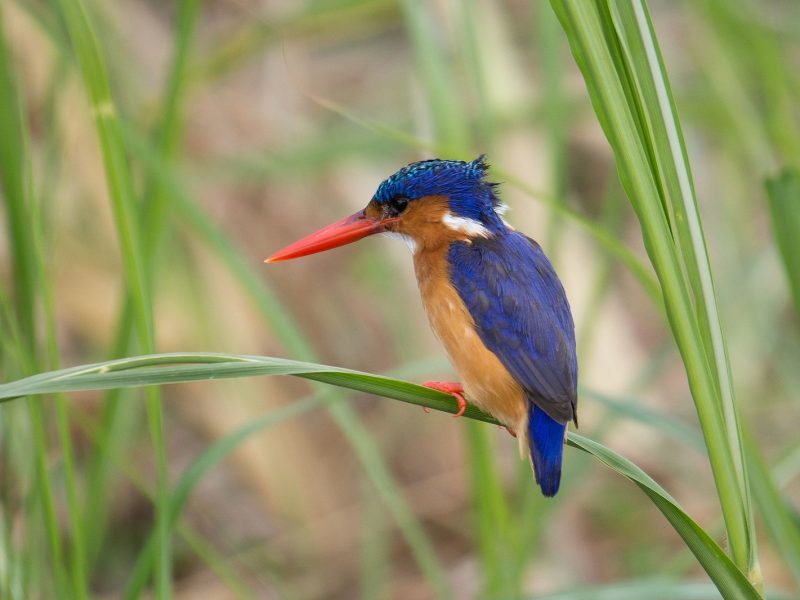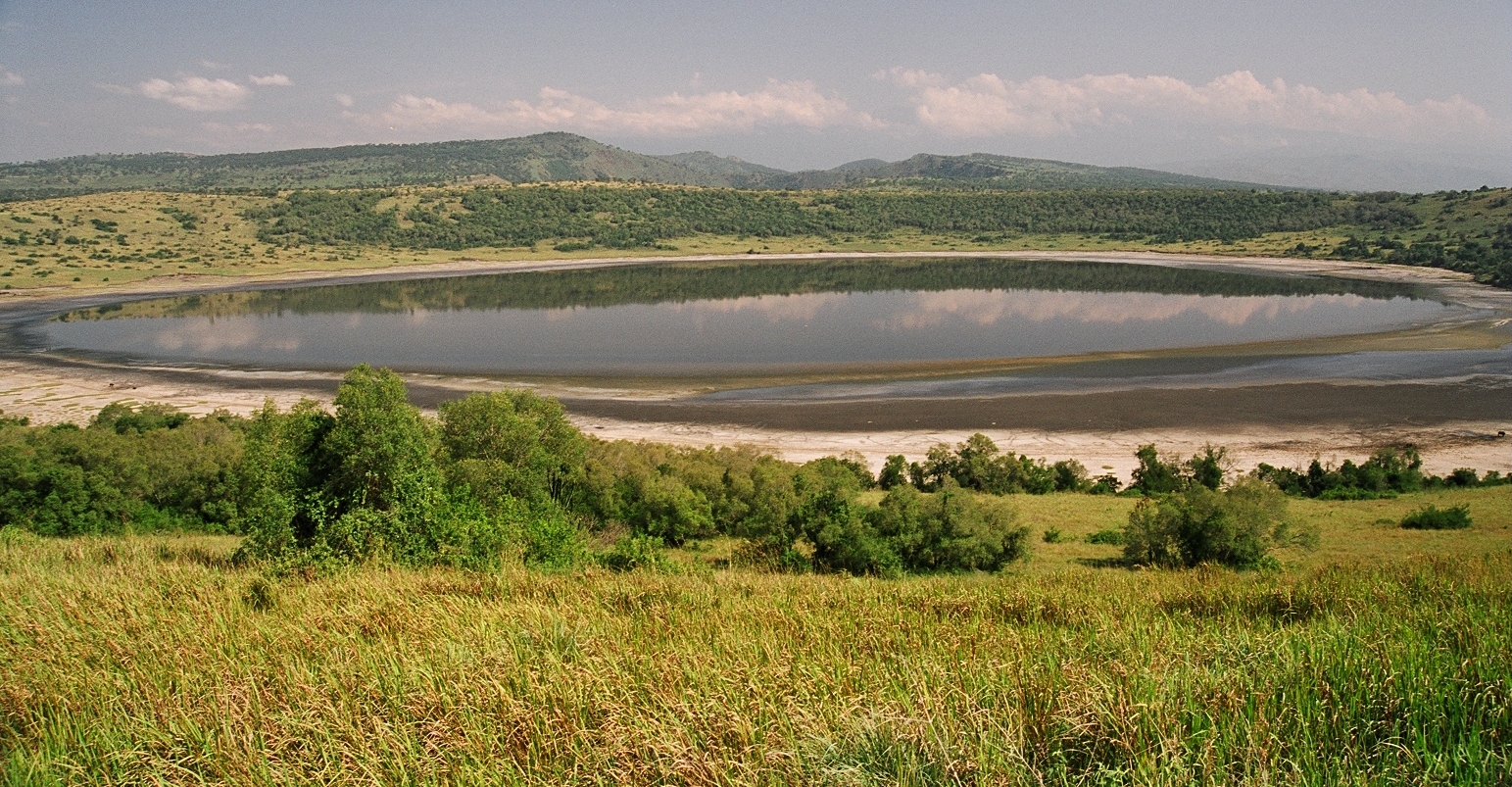Queen Elizabeth National Park was founded in 1952 as Kigezi National Park and was renamed after later as Queen Elizabeth National Park. Queen Elizabeth National Park is in the Western Region of Uganda and it falls in the districts of Kasese, Rubirizi, Kamwenge and Runkugiri. The park is approximately 400 kilometres (250 mi) by road south-west of Kampala, Uganda’s capital and largest city.The town of Kasese is just outside the northeastern edge of the park, while the town of Rubirizi is just outside the park’s southeastern boundaries. The park includes the Maramagambo Forest and borders the Kigezi Game Reserve, the Kyambura Game Reserve, and the Kibale National Park in Uganda, and the Virunga National Park in the Democratic Republic of the Congo.
Queen Elizabeth National Park occupies an estimated 1,978 square kilometres (764 sq mi) .The Park extends from Lake George in the north-east to Lake Edward in the south-west and includes the Kazinga Channel connecting the two lakes.
Queen Elizabeth National Park is known for its wildlife, including African buffalo, Ugandan kob, hippopotamus, giant forest hog, warthog, Nile crocodile, African bush elephant, African leopard, lion, and chimpanzee. It is home to 95 mammal species and over 500 bird species. The area around Ishasha in Rukungiri District is famous for its tree-climbing lions, whose males sport black manes. Poachers killed six elephants in the park in 2015, triggering both anger and frustration within the Ugandan conservation community.
Activities in Queen Elizabeth National Park
Launch Boat trips
The Kazinga Channel is an oasis for many of the fascinating species that inhabit the park, and taking a boat tour along it gives visitors the chance to cruise just meters from hundreds of enormous hippos and buffalos while elephants linger on the shoreline.
An average of 60 bird species can be spotted during the trip. Carrying up to 40 passengers, the boats guarantee a seat with a view, while expert ranger guides narrate the creatures’ stories.
Launch trips last two hours and run three or four times a day.
Game drives
For a classic African safari experience, the tracks through Kasenyi, the North Kazinga Plains and the Ishasha Sector offer virtually guaranteed buffalo, antelope and elephant sightings, along with warthogs and baboons. Taking an experienced guide in the early morning or at dusk is the most successful way to track down a pride of lions, and maybe even the odd leopard
Kasenyi plains
The open grasslands of Kasenyi provide QENP’s primary game viewing area, thanks to resident herds of Uganda kob and the lions that prey on them. The park’s experienced ranger guides can usually locate lions but predator sightings can be guaranteed by signing up for a tour with the Mweya-based Uganda Predator Project which monitors the movement of lions, leopards and hyaenas fitted with radio collars.
Ishasha
QENP’s southernmost sector offers a classic game viewing experience under vast rift valley skies. Expect to see buffaloes, hippos, elephants, topis and more besides. The chance of sighting lions is particularly good in Ishasha; the local prides obligingly spend their days resting up in the branches of shady fig trees.
Chimpanzee Tracking
The Kyambura Gorge experience is more than discovering chimpanzees in their natural environment: it teaches visitors about the ecosystems of Kyambura Gorge’s atmospheric “underground” rainforest, including vegetation types; bird identification and behavior; and chimp and monkey ecology.
Although chimp sightings are not guaranteed, visitors stand a pretty good chance of hearing and seeing our distant cousins as they are habituated. Tours last between one and three hours and start at 8am and 2pm daily.

Birding
Classified as an Important Birding Area (IBA) by Birding International, Queen’s great variety of habitats mean it is home to over 600 species. This is the greatest of any East African national park and a phenomenal number for such a small area. The park’s confluence of savanna and forest, linking to the expansive forests of the DR Congo allow visitors to spot East as well as Central African species.
Present in the park is numerous water birds, woodland and forest dwellers in the Maramagambo Forest, 54 raptors and various migratory species. Key species include the Martial Eagle, Black-rumped Buttonquail, African Skimmer, Chapin’s Flycatcher, Pink-backed Pelican, African Broadbill, Verreaux’s Eagle Owl, Black Bee-eater, White-tailed Lark, White-winged Warbler, Papyrus Gonolek, Papyrus Canary, Corncrake, Lesser and Greater Flamingo, Shoebill, Bar-tailed Godwit.
For the best birding in Queen Elizabeth National Park, don’t miss these birding hot spots:
Kazinga Channel, Kasenyi Area, Mweya Peninsula, Maramagambo Forest, Ishasha Sector, Lake Kikorongo, Katunguru Bridge area and Katwe Area Tours can be booked through Katwe Tourism Information Center.
Cultural Encounters
See the energetic dances of the Kikorongo Equator Cultural Performers; workers harvesting salt on Katwe Salt Lake; a traditional Banyaraguru hut; or an agricultural village – all guided by those who know them best – local community members.
Leopard Village
Leopard Village is a community-run, socio-economic development initiative that promotes cultural and wildlife conservation through ecotourism. Located near the village of Muhokya, Leopard Village sits on 3 acres bordering the northern sector of Queen Elizabeth National Park.
Visitors can tour replicas of the traditional huts of the Banyabindi, Bakonzo, and Basongora ethnic groups, watch traditional song and dance performances, and purchase handicrafts made by local communities.
Longer visits can include conversations with community members about the challenges and opportunities they face living next to the park, visits to local schools, and discussions about traditional village life and solutions for human-wildlife conflict. We can work with tour groups to create a customized program.
Leopard Village is a partnership between the local communities of Muhokya, Kahendero and Hamukungu, and the Uganda Carnivore Program, with support from zoos in the United States and Germany. All fees and donations go directly to community development, conservation and education projects, and to the individual artists. By supporting Leopard Village tourist and cultural activities, you will be assisting in the conservation of the area’s wildlife and supporting sustainable development in the local communities.
Wildlife Research Tours
For visitors who yearn to get up close to wild African fauna, a research trip is a rewarding adventure. This new and unique experience allows visitors to actively participate in monitoring some of the exotic birds and mammals that fill the park, using locator devices and learn habituation calls, as well as monitoring weather, surroundings and behavior. The results are added to researchers’ databases, contributing valuable information to the overall understanding of wildlife ecology – and helping to conserve this wonderful ecosystem.
The experiential tourism activities currently available are Mongoose Tracking, Lion Tracking, Hippo Census, and Bird Counts. The number of people on each outing is limited in order to reduce stress on the animals and to increase the quality of the experience for visitors.
Experiential tours lasts between one and three hours. They usually take place in the early morning or evening, or occasionally at night. All activities must be booked through the Visitor Information Centre in Mweya at least 24 hours in advance.
Hiking/Nature walks
Nature treks are one of the more active ways to explore the landscapes and wildlife of Queen Elizabeth. Locations include the shady Maramagambo forest; Mweya Peninsula with its scenic views; and Ishasha River, where you may spot a variety of forest and savanna species as well as having a unique opportunity to get extremely close to hippos – on foot!
Mweya Peninsula offers savannah and woodland with beautiful views and bold warthogs. At the southern end of the park, visitors can enjoy an easy stroll along the Ishasha River, where they can spot a variety of forest and savanna bird and mammal species as well as having a unique opportunity on this walk to get extremely close to hippos on foot, while remaining perfectly safe on the raised bank above the river.


Comment (0)